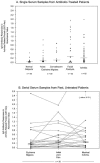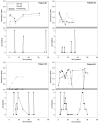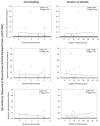Human Lyme arthritis and the immunoglobulin G antibody response to the 37-kilodalton arthritis-related protein of Borrelia burgdorferi
- PMID: 15845501
- PMCID: PMC1087337
- DOI: 10.1128/IAI.73.5.2951-2957.2005
Human Lyme arthritis and the immunoglobulin G antibody response to the 37-kilodalton arthritis-related protein of Borrelia burgdorferi
Abstract
In Borrelia burgdorferi-infected C3H-scid mice, antiserum to a differentially expressed, 37-kDa spirochetal outer-surface protein, termed arthritis-related protein (Arp), has been shown to prevent or reduce the severity of arthritis. In this study, we determined the immunoglobulin G (IgG) antibody responses to this spirochetal protein in single serum samples from 124 antibiotic-treated human patients with early or late manifestations of Lyme disease and in serial serum samples from 20 historic, untreated patients who were followed longitudinally from early infection through the period of arthritis. These 20 patients were representative of the spectrum of the severity and duration of Lyme arthritis. Among the 124 antibiotic-treated patients, 53% with culture-proven erythema migrans (EM) had IgG responses to recombinant glutathione S-transferase (GST)-Arp, as did 59% of the patients with facial palsy and 68% of those with Lyme arthritis. In addition, 75 to 80% of the 20 past, untreated patients had reactivity with this protein when EM was present, during initial episodes of joint pain, or during the maximal period of arthritis. There was no association at any of these three time points between GST-Arp antibody levels and the severity of the maximal attack of arthritis or the total duration of arthritis. Thus, after the first several weeks of infection, 60 to 80% of patients had IgG antibody responses to GST-Arp, but this response did not correlate with the severity or duration of Lyme arthritis.
Figures



Similar articles
-
Antibody responses to Borrelia burgdorferi in patients with antibiotic-refractory, antibiotic-responsive, or non-antibiotic-treated Lyme arthritis.Arthritis Rheum. 2007 Dec;56(12):4216-25. doi: 10.1002/art.23135. Arthritis Rheum. 2007. PMID: 18050219
-
Immunogenicity of Borrelia burgdorferi arthritis-related protein.Infect Immun. 2003 Dec;71(12):7211-4. doi: 10.1128/IAI.71.12.7211-7214.2003. Infect Immun. 2003. PMID: 14638819 Free PMC article.
-
Prospective study of serologic tests for lyme disease.Clin Infect Dis. 2008 Jul 15;47(2):188-95. doi: 10.1086/589242. Clin Infect Dis. 2008. PMID: 18532885 Free PMC article.
-
[Diagnosis and treatment of Lyme arthritis].Przegl Epidemiol. 2006;60 Suppl 1:125-30. Przegl Epidemiol. 2006. PMID: 16909789 Review. Polish.
-
Lyme Disease.Ann Intern Med. 2025 May;178(5):ITC65-ITC80. doi: 10.7326/ANNALS-25-01111. Epub 2025 May 13. Ann Intern Med. 2025. PMID: 40354663 Review.
Cited by
-
Anti-p19 antibody treatment exacerbates lyme arthritis and enhances borreliacidal activity.Clin Vaccine Immunol. 2007 May;14(5):510-7. doi: 10.1128/CVI.00005-07. Epub 2007 Mar 14. Clin Vaccine Immunol. 2007. PMID: 17360856 Free PMC article. Clinical Trial.
-
Evidence that the BBA68 protein (BbCRASP-1) of the Lyme disease spirochetes does not contribute to factor H-mediated immune evasion in humans and other animals.Infect Immun. 2006 May;74(5):3030-4. doi: 10.1128/IAI.74.5.3030-3034.2006. Infect Immun. 2006. PMID: 16622245 Free PMC article.
-
Human homologues of a Borrelia T cell epitope associated with antibiotic-refractory Lyme arthritis.Mol Immunol. 2008 Jan;45(1):180-9. doi: 10.1016/j.molimm.2007.04.017. Epub 2007 Jun 6. Mol Immunol. 2008. PMID: 17555819 Free PMC article.
-
Influence of arthritis-related protein (BBF01) on infectivity of Borrelia burgdorferi B31.BMC Microbiol. 2013 May 7;13:100. doi: 10.1186/1471-2180-13-100. BMC Microbiol. 2013. PMID: 23651628 Free PMC article.
-
Searching for borrelial T cell epitopes associated with antibiotic-refractory Lyme arthritis.Mol Immunol. 2008 Apr;45(8):2323-32. doi: 10.1016/j.molimm.2007.11.010. Epub 2008 Jan 11. Mol Immunol. 2008. PMID: 18191206 Free PMC article.
References
-
- Ausubel, F., R. Brent, R. E. Kingston, D. D. Moore, J. G. Seidman, J. A. Smith, and K. Struhl (ed.). 2000. Expression and purification of glutathione-S-transferase fusion proteins, p. 16.71-16.75. In Current protocols in molecular biology. Wiley, New York, N.Y. - PubMed
-
- Barthold, S. W., S. Feng, L. K. Bockenstedt, E. Fikrig, and K. Feen. 1997. Protective and arthritis-resolving activity in sera of mice infected with Borrelia burgdorferi. Clin. Infect. Dis. 25:S9-S17. - PubMed
-
- Centers for Disease Control. 1990. Case definitions for public health surveillance. Morb. Mortal. Wkly. Rep. 39:1-43. - PubMed
Publication types
MeSH terms
Substances
Grants and funding
LinkOut - more resources
Full Text Sources
Medical
Research Materials
Miscellaneous

